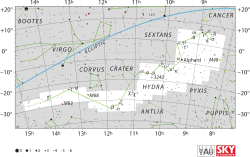HD 96819
| HD 96819 | |
 | |
| Observationsdata Epok: J2000.0 | |
|---|---|
| Stjärnbild | Vattenormen |
| Rektascension | 11t 08m 43,99954s[1] |
| Deklination | -28° 04′ 50,4127″[2] |
| Skenbar magnitud () | +5,43[3] |
| Stjärntyp | |
| Spektraltyp | A1 V[4] |
| U–B | +0,06[5] |
| B–V | +0,07[5] |
| Variabeltyp | Misstänkt variabel[6] |
| Astrometri | |
| Radialhastighet () | 16,0 ± 7,4[7] km/s |
| Egenrörelse (µ) | RA: -72,79[2] mas/år Dek.: -22,16[2] mas/år |
| Parallax () | 17,97 ± 0,53[2] |
| Avstånd | 182 ± 5 lå (56 ± 24 pc) |
| Absolut magnitud () | 1,61[3] |
| Detaljer | |
| Massa | 2,06 ± 0,03[4] M☉ |
| Radie | 1,9[3] R☉ |
| Luminositet | 20,66[4] L☉ |
| Temperatur | 8 954[4] K |
| Vinkelhastighet | 249[4] km/s |
| Ålder | 9 ± 1[8] miljoner år |
| Andra beteckningar | |
| HD 96819, CD-27 7886, CPD-27 4269, GSC 06644-01332, HIC 54477, HIP 54477, HR 4334, IRAS 11063-2748, 2MASS J11084400-2804504, NSV 5101, PLX 2594, PPM 258592, SAO 179577, TD1 15406, TYC 6644-1332-1, uvby98 100096819, Gaia DR2 3532027383058513664 [9] | |
HD 96819 är en ensam stjärna[10] belägen i den södra delen av stjärnbilden Vattenormen och har tidigare varit betecknad 10 Crateris. Den har en skenbar magnitud på 5,43[3] och är svagt synlig för blotta ögat där ljusföroreningar ej förekommer. Baserat på parallaxmätning inom Hipparcosuppdraget på ca 18,0[7] mas, beräknas den befinna sig på ett avstånd på ca 182 ljusår (ca 56 parsek) från solen. Den rör sig bort från solen med en heliocentrisk radialhastighet på ca 16 km/s.[2] Den ingår med största sannolikhet i TW Hydrae-associationen.[8]
Egenskaper[redigera | redigera wikitext]
HD 96819 är en vit till blå stjärna i huvudserien av spektralklass A1 V,[3] som har avverkat omkring en tredjedel av sin tid i huvudserien och senare kommer att expandera till en röd jätte.[4] Den har en massa som är ca 2[4] solmassor, en radie som är ca 1,9[3] solradier och utsänder från dess fotosfär ca 21[4] gånger mera energi än solen vid en effektiv temperatur av ca 9 000[4] K.
HD 96819 är en ung, snabbt roterande stjärna, omkring 9 miljoner år gammal och en misstänkt variabel. [6]
Se även[redigera | redigera wikitext]
Referenser[redigera | redigera wikitext]
- Den här artikeln är helt eller delvis baserad på material från engelskspråkiga Wikipedia, HD 96819, 2 januari 2020.
Noter[redigera | redigera wikitext]
- ^ Brown, A. G. A.; et al. (Gaia collaboration) (August 2018). "Gaia Data Release 2: Summary of the contents and survey properties". Astronomy & Astrophysics. 616. A1. arXiv:1804.09365. Bibcode:2018A&A...616A...1G. doi:10.1051/0004-6361/201833051. Gaia DR2 record for this source at VizieR.
- ^ [a b c d e] van Leeuwen, F.; et al. (2007). "Validation of the new Hipparcos reduction". Astronomy and Astrophysics. 474 (2): 653–664. arXiv:0708.1752. Bibcode:2007A&A...474..653V. doi:10.1051/0004-6361:20078357.
- ^ [a b c d e f] Allende Prieto, C.; Lambert, D. L. (1999). "Fundamental parameters of nearby stars from the comparison with evolutionary calculations: masses, radii and effective temperatures". Astronomy and Astrophysics. 352: 555–562. arXiv:astro-ph/9911002. Bibcode:1999A&A...352..555A.
- ^ [a b c d e f g h i] Zorec, J.; Royer, F. (2012). "Rotational velocities of A-type stars. IV. Evolution of rotational velocities". Astronomy & Astrophysics. 537: A120. arXiv:1201.2052. Bibcode:2012A&A...537A.120Z. doi:10.1051/0004-6361/201117691.
- ^ [a b] Johnson, H. L. (1966). "UBVRIJKL Photometry of the Bright Stars". Communications of the Lunar and Planetary Laboratory. 4: 99. Bibcode:1966CoLPL...4...99J.
- ^ [a b] Samus, N. N.; et al. (2017), "General Catalogue of Variable Stars", Astronomy Reports, 5.1, 61 (1): 80−88, Bibcode:2017ARep...61...80S.
- ^ [a b] Kharchenko, N. V.; et al. (2007). "Astrophysical supplements to the ASCC-2.5: Ia. Radial velocities of ~55000 stars and mean radial velocities of 516 Galactic open clusters and associations". Astronomische Nachrichten. 328 (9): 889. arXiv:0705.0878. Bibcode:2007AN....328..889K. doi:10.1002/asna.200710776.
- ^ [a b] Gagné, Jonathan; et al. (February 2017), "BANYAN. IX. The Initial Mass Function and Planetary-mass Object Space Density of the TW HYA Association", The Astrophysical Journal Supplement Series, 228 (2): 51, arXiv:1612.02881, Bibcode:2017ApJS..228...18G, doi:10.3847/1538-4365/228/2/18, 18.
- ^ "HD 96819". SIMBAD. Centre de données astronomiques de Strasbourg. Hämtad 22 augusti 2017.
- ^ Eggleton, P. P.; Tokovinin, A. A. (September 2008), "A catalogue of multiplicity among bright stellar systems", Monthly Notices of the Royal Astronomical Society, 389 (2): 869–879, arXiv:0806.2878, Bibcode:2008MNRAS.389..869E, doi:10.1111/j.1365-2966.2008.13596.x.





